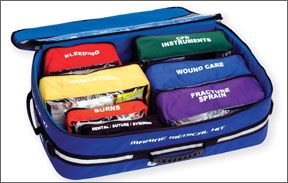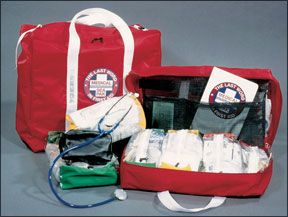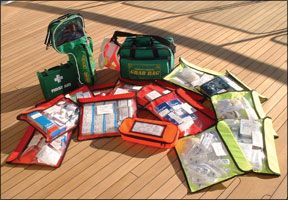This is the final installment in Practical Sailor’s four-part series on medical kits for sailing. This article looks at Group IV pre-packaged first-aid kits, which are expected to sustain the crew during an extended cruise or ocean passage. Previous articles tapped the best medical kits for daysailors, coastal cruisers, and offshore cruisers. The Group IV kits must provide supplies and medications needed not only for first aid, but sometimes for extended treatment of even the worst injuries and the most serious illnesses. They must enable sailors to cope with anything that can happen to a person at sea for days on end. Test kits included the Adventure Medical Marine 3000, Filedtex Trans-Ocean Pak, and Ocean Medical International’s Class A medical kit. All three kits were stocked with most of the first-aid components that testers outlined as necessary for an offshore cruise. Although the OMI kit was clearly the most comprehensive, its price was prohibitively high. The Trans-Ocean Pak from FieldTex was well-stocked and well-organized, but PS found the kit by Adventure Medical to be the best choice.
****

Photo by Dave Kneale
288
This is the final installment in our series of four articles on seagoing medical kits. The kits evaluated this month, Group IV kits, are expected to sustain the crew aboard a vessel engaged in extended cruising or ocean passagemaking.
This is the ultimate test, not only of a boat and its crew, but also of all the gear on board, including medical kits. These vessels operate hundreds, even thousands, of miles from any source of assistance, and the ability to cope with every circumstance independently is vitally important to the offshore sailor.
Group IV medical kits must provide supplies and medications needed not only for first aid, but sometimes for extended treatment of even the worst injuries and the most serious illnesses.
Consequently, the Group IV medical kits should contain more components than the other groups because they must enable sailors to cope with anything that can happen to a person at sea for days on end. Only one of the kits featured in this comparison, the Ocean Medical International Class A, includes prescription medicines. Any true offshore medical supply chest will need to include a full complement of antibiotics, pain medication, and other essential prescription drugs; this will add substantially to the expense of the kit. (International voyagers can save a good deal of money by purchasing name-brand prescription medicines abroad.) Regardless of where you buy your prescriptions, you will need to work closely with a doctor to stock your kit with quality drugs. One company, OceanMedix.com, has for several years specialized in stocking prescription medical kits for offshore mariners.
Of course, prescription drugs, catheters, intravenous bags, and the other items you find in these kits are not much help unless someone on board knows how to use them. The required knowledge base extends beyond what a typical American Red Cross course has to offer, so sailors may want to look into courses available through local colleges, hospitals, or maritime schools.
Since 1995, the Standards and Training Certification and Watchkeeping code has established basic criteria for certifying proficiency in medical first aid, and many maritime colleges specialize in these certification courses. For those who like to mix training with pleasure, Dr. Michael Jacobs, author of the “Comprehensive Guide to Marine Medicine,” will be leading a training junket in the British Virgin Islands this winter (www.medicineformariners.com).
Another key component not to be overlooked is telemedicine. There are a handful of companies that specialize in providing 24-hour on-call service to mariners, including Marine Medical International (www.marmed.com), Maritime Medical Access at George Washington University (www.gwemed.edu), and First Call (www.thefirstcall.com). If you plan to use a telemedicine provider, you will want to stock your medical kit under their guidance.
Although Practical Sailor has not evaluated these services, we have received good reports regarding the Maritime Medical Access at George Washington University. We would be interested in any feedback from cruisers who have used any of the telemedecine services for sailors.
Even with modern technology, ships can only steam so fast, and the maximum range for most helicopters is roughly 300 miles. If you contact a shoreside base

Volvo Ocean Race
288
and request an evacuation because a crew member has broken his or her femur, for example, an interagency and international search will begin to locate any vessel within your vicinity. If there is one close by, that’s wonderful, but if not, the victim will have to be sustained and monitored using only the knowledge and equipment on board, coupled with any advice that can be obtained by VHF radio or Satcom.
With Group IV kits, it’s critical that before departure for an offshore passage, the skipper conduct a thorough orientation with his crew. Everyone on board needs not only to know where the kit is stowed, but should be capable of hauling it out and demonstrating its contents, including any reference books and manuals, and emergency contact numbers.
Group IV Candidates
The standards we’ve constructed for Group IV kits suggest the minimum complement for a vessel operating under the circumstances described above. Aside from having more of the elements than kits in the other groups tested, Group IV kits must have more of those items to sustain crewmembers for longer periods of time.
It’s imperative that each crew bring any personal medications that he or she takes on a continuing basis or medications taken in special circumstances. No crewmember should trust that the onboard medical kit will have their specific prescriptions. Personal medications will include things like injectable adrenalin for allergic episodes, asthma inhalers, cardiac medications like nitrogen tablets, antidepressants taken regularly, birth-control pills, insulin, and antibiotics.
In addition, crewmembers should take along signed prescription orders for medication refills in excess of the projected quantities, just in case. As always, a skipper should ask each crew about his or her personal medications and enter the dosage schedules in the log, along with what clinical signs to expect if the person misses any doses.
Adventure Medical
Marine 3000
Adventure Medical makes eight different marine medical kits, and the Marine 3000 is the company’s top-of-the-line item. It contains seven injury- or sickness-specific modules, including dental, wound care, medicine, bleeding, CPR/instrument, blister/burn, and fracture/sprain. Each water-resistant module is clearly identified with its contents easily viewed via a large vinyl window.
It may be comforting to know that if you take this kit to sea, it will enable you to deal with some fairly intricate emergency medical situations. A Foley catheter, an enema bag, and nasal airway tubes are supplied, as are a stethoscope, temporary cavity fillings, and a skin stapler.
Not only is the Marine 3000 well-stocked with supplies, medicine, and equipment, it

288
is contained in a well-designed and manufactured case. This padded nylon valise opens by way of a water-resistant zipper that helps keep out moisture. The bag, which is made of 500 denier nylon, is encircled with a reflective band that helps users locate the case at night or in low-light situations.
The Marine 3000 also comes with one of the best reference manuals in the business: Dr. Eric Weiss’ and Dr. Michael Jacobs’ “A Comprehensive Guide to Marine Medicine.” The cost of the Marine 3000 is $795, less than all of the other kits tested in this group.
Bottom line: The 3000 is a comprehensive kit that’s well organized and comes in a well-protected case. Receiving the highest combined ratings, it is hands-down our Best Choice in Group IV.
Fieldtex Trans-Ocean Pak
The list of supplies in the Trans-Ocean Pak from Fieldtex is quite extensive. It contains 13 separate modules, each one dedicated to a particular kind of injury or illness. The only supplies lacking here were IV catheters and sterile fluids in case of dehydration or shock.
As with most of the other medical kits from Fieldtex, the user will need to supplement numerous medications, which may be inconvenient for some, but likely what most long-range cruising crews would anticipate having to do in preparation for departure.
We evaluated the soft bag version of the Trans-Ocean Pak, which is lightweight but not shock-resistant. Unless particularly well stowed, items in this kit could be damaged when subjected to rough seas. We’d recommend that serious offshore sailors replace the soft bags with a hard case, which Fieldtex sells for an additional $230. With that added to the price of the Trans-Ocean kit ($899 for the soft case), the total is $1,129.
Packaged in the hard case and supplemented with medications, the Trans-Ocean Pak should be seriously considered for Group IV application.
Bottom line: A well-stocked, well-organized medical kit that should serve sailors well in the given circumstances. We’d rather have some medications supplied. That and the few items missing from our required list of standards are what hold this kit back.
OMI Class A Kit

288
The Class A Kit from Ocean Medical International includes three padded nylon bags stocked with materials. This is extremely well-supplied gear, with far more items than stipulated by our minimum group standards.
Each bag contains modules dedicated to a specific medical need or treatment, and each module carries clear labels and instructions. The Class A Kit also includes what OMI calls a “Grab Bag” for initial responses to medical emergencies.
As with each of the other products that PS tested from OMI, there is an abundance of supplies and medications, including a full oxygen module and a defribillator. This kit is advertised as appropriate for a crew of up to 10 voyaging well offshore, more than 24 hours from professional medical attention.
The Class A Kit follows OMI’s pattern of high quality and quantity of supplies, which certainly enables treatment of a broad range of injuries and illnesses. However, the same quality doesn’t extend to the cases. These are essentially made with nylon cloth sewn over thin sections of foam, meaning that the containers are lightweight, but they also offer minimal shock resistance and questionable water integrity.
As was true of the OMI kits in previous evaluations, this one seems better suited to the infirmary of a cruise ship than a 40-foot sailboat. Additionally, the extremely high cost of the OMI Class A Kit—$6,740—would likewise be better absorbed by an income-generating cruise ship with several hundred paying passengers.
Bottom line: A very complete kit that is organized in easy-to-identify modules with a plenitude of medications. Though defibrillators are critical when needed, we still can’t justify spending almost $7,000 for an offshore medical kit when there are less expensive, high quality options available.
Conclusions
Though the kit supplied by Ocean Medical International is clearly the most comprehensive in this group, we feel that most sailors would be apt to dismiss that product due to its extremely high cost. It’s appropriate to reiterate, however, that this company does hold its products to a very high standard (the British Maritime and Coast Guard Agency regulations) and does offer less expensive medical kits. Additionally, OMI is the only company whose products we tested that offers medical consultation with trained professionals on a 24-hour basis via electronic communication, but that service is priced separately.
We also like the contents and organization of the Trans-Ocean Pak from Fieldtex, and we only found fault with its lack of some required contents. However, the best bargain in this group comes from Adventure Medical—the Marine 3000. To date, this company has supplied us with the winning kit in each prior grouping, and when all the parameters have been examined, that goes for Group IV as well.








































